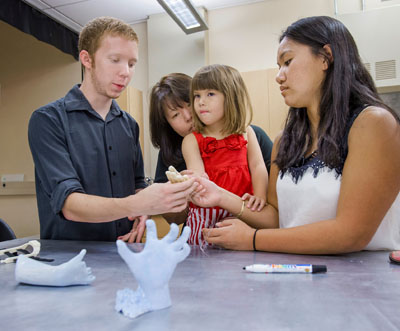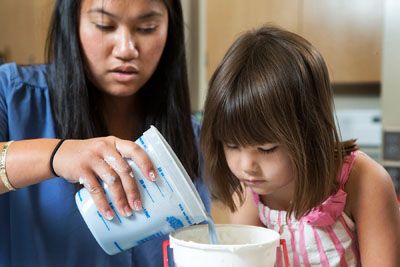Katherine Lau, a junior biomedical engineering major in the Douglass Residential College, got the chance this summer to do something few undergraduates have done: lead a team that created a prosthesis for a 4-year-old girl born with barely developed fingers on her right hand.
“Getting that opportunity was a great experience,” Lau said. “The reason I want to be a biomedical engineer is to improve the lives of others. This summer, I got to see what my work can do for people.”
Hailey Dawson had been born with Poland syndrome, a birth defect marked by incomplete development of hand and chest muscles typically on a person’s right side. Lau’s team used 3D printing to make the fingers and mechanical linkages for the girl’s prosthetic hand.
The strategy was not new – there are several designs in the public domain for 3D printed hands. But the engineering challenge was to make the hand fit the young girl’s size and accommodate the nature of her deformity.
Lau was able to get this opportunity with assistance from the Douglass Residential College’s STEM (science, technology, engineering and mathematics) summer stipend program. She applied to the program early last spring, hoping to land an internship at a nearby technology firm. Although that offer didn’t come through, Lau still qualified for a research stipend.
She thought it made sense to head home to Las Vegas, Nevada, and look for research opportunities nearby. Through her family, Lau learned of Brendan O’Toole, a mechanical engineering professor at the University of Nevada, Las Vegas (UNLV). Earlier that year, Las Vegas resident Yong Dawson had asked if university engineers could build a prosthesis for her daughter for less than the tens of thousands of dollars that a commercial one would cost. O’Toole saw it as a dream engineering project, involving design and assembly challenges.
Lau corresponded with O’Toole and was thrilled to get an offer to work in his lab. O’Toole assigned her the role of project leader, working with another undergraduate and two high school students. She was grateful that the Douglass funding allowed her to conduct research away off campus, mainly so she could save money by living at home but also so she could learn about another institution and broaden her professional network.
Rutgers’ Laura Stiltz manages the program that provided Lau and 42 other women with $3,000 each in stipends – essentially salaries to perform research. The intent is to prepare more women to pursue careers in STEM fields, and to give women who would otherwise have to accept unrelated summer employment to support themselves the chance to stay engaged in their fields of interest.
“Having lab experiences like these boosts our students’ confidence,” said Stiltz, director of Douglass Project research programs and advising. “They see how what they learn in class relates to the real world.”Women make up a bit less than 40 percent of the biomedical engineering majors nationwide – a percentage more than twice as high as their representation in all of the engineering majors.
Stiltz believes women are drawn to biomedical engineering because “it’s easier for them to make the connection between that field and their interests in health and helping people,” she said.
Nevertheless, some women change majors as undergraduates or leave engineering altogether to pursue other fields, like physical therapy and medicine, after earning their degrees. The total number of graduates in biomedical engineering is still low at 4,374, compared to 89,000 in engineering overall. So there are many opportunities for women in this growing major.
“We want to encourage more women to pursue graduate study or industrial positions in biomedical engineering,” Stiltz said.
Lau was drawn to science and math throughout her school years, so she knew a career in engineering or medicine might suit her.
“While I was in high school, I was watching an Oprah episode where Dr. Oz was talking about stem cell treatment. He showed us how an organ had been regrown from stem cells, and I said, ‘that’s what I want to do.’” Her cousin from Hawaii was doing postdoctoral work in pharmacy at Rutgers, and he played up the benefits of the school and recommended trying a different part of the country.
Though she was accepted by many schools, Rutgers was good financially – and “had the best engineering program for what I wanted to study,” she said.
When she arrived at Rutgers in 2012, she was one of 20 women in the Douglass Women in Engineering Living Learning Community on the Busch Campus – the first established off the Douglass Campus. She remains active in the community as a mentor to new School of Engineering undergraduates.
Lau continued her work in Las Vegas right up until the week she had to return to Rutgers. She found interacting directly with Hailey and her family fulfilling and inspirational.
“Hailey is so confident,” Lau said. “Even though she has these deformities, she doesn’t think twice about it. She just says, ‘this is my special hand,’ and she shows it off to everyone.”
Although Lau has moved on, UNLV Professor O’Toole will stay involved, tasking his students to improve on Lau’s design for their senior projects. Hailey will need to be fitted with bigger prosthetics as she grows.
Back at Rutgers, Lau ponders what lies ahead for her.
“On Monday, I want to be a doctor. On Wednesday, I want to be an engineer who does research. On Friday, I want to be a professor. My major has so many options that I’m just trying to figure out which one I want to do.”




